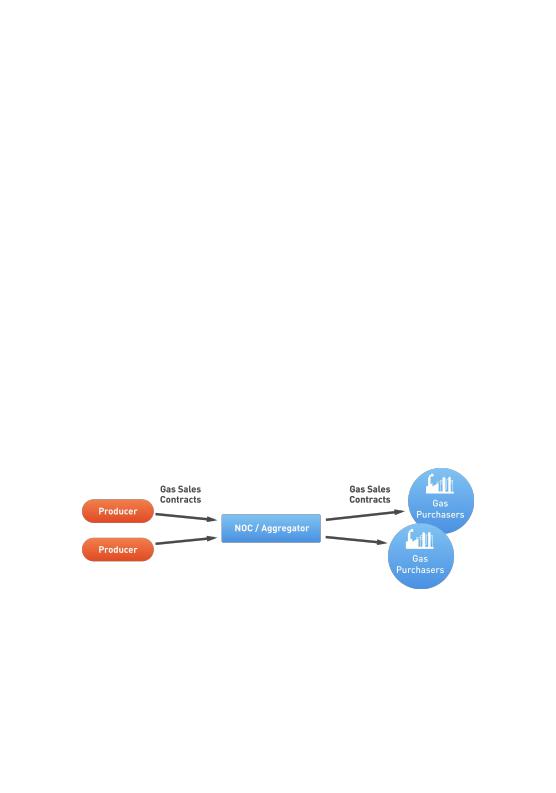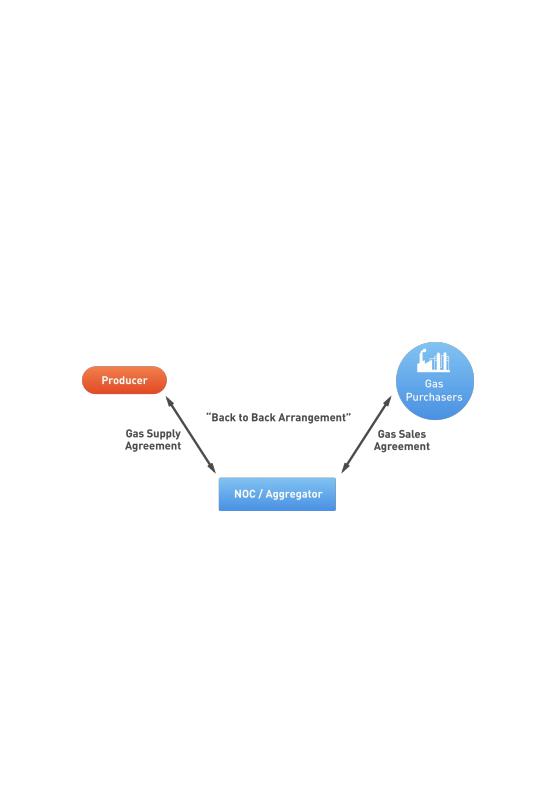
01 POWER ISLAND / 01 CCPP / DOE__Understanding Natural Gas and Lng Options October 11 2017_1
.pdf
DOMESTIC MARKET
Gas-to-Power Value Chain Implementation
Successful implementation of a gas-to-power value chain depends on the ability of each party to execute the elements for which it is responsible in a timely manner and in coordination with other parties. Below is a table that shows examples of construction and ownership arrangements:
Party |
Supply Chain Ownership |
|
|
|
|
Upstream Investor |
Raw gas production / Offshore pipeline / Onshore gas treatment plant |
|
|
|
|
Pipeline Investor |
Pipeline connecting gas treatment plant to the power plant |
|
|
|
|
IPP |
Power plant |
|
|
|
|
Utility Company |
Transmission lines, substations and distribution network |
|
|
|
|
A successful gas-to-power project typically has each party having the technical, financial and operational capability to undertake its respective investment. The parties must coordinate their plans, including development, construction, and financing plans, in a way that enables timely final investment decisions (FID) and startup of the entire value chain. In cases where the government-owned utility company is responsible for funding and constructing transmission and distribution networks, it must plan for and budget towards the large investments required, and provide confidence to other investors on the availability of government funds and its ability to complete the transmission and distribution networks. Likewise, other investors in the value chain will need to demonstrate the ability to complete their respective segment of the value chain in a timely manner.
36

DOMESTIC MARKET
Power Generation Investment
Power plants are capital-intensive, long-term investments. Independent power producer (IPP) investors require, among other things, steady revenue from a creditworthy power offtaker (customer) under a power purchase agreement (PPA), reliable fuel gas supply, and a stable legal, regulatory, and taxation environment. To attract IPP investment, host governments will need to provide the necessary legal and regulatory framework in the gas and electricity sector to underpin the PPA which typically has a duration of 20 or more years. Under a conducive investment environment, the IPP will be able to secure project financing as well as payment securitization provided by multilateral agencies such as the World Bank and African Development Bank.
37

DOMESTIC MARKET
Market Structure
The ability of local or regional gas and power markets to partially or wholly underpin a major gas resource development depends largely on the way in which the wholesale and retail gas and power markets are structured.
The market segments for natural gas are supply, wholesale, and retail. Each market segment can be structured as exclusive, mixed, or competitive, with prices either regulated or market-based. In the supply segment, the producer sells to an aggregator or directly to an end-user. In the wholesale segment, an entity, such as an aggregator, purchases gas from another entity for resale to other customers. In the retail segment, an end-user purchases gas from an entity for its own use.
An example of an exclusive structure is shown below. A gas aggregator, for example the national oil or gas company, acquires natural gas, provides transportation and compression, if required, and then on-sells the natural gas to wholesale and retail customers.
Of critical importance in any energy market, is a clear and dependable path through which end-users pay for energy received. The flow of energy from the gas developer through to the end-user and the flow of funds in the opposite direction are the key feature of any market and the critical
38

DOMESTIC MARKET
facilitating feature of any project. For domestic and regional markets to provide dependable revenues similar to that which would result from gas or LNG exports to international markets, appropriate planning and execution of market rules, and the nature and level of regulation, are critical factors.
One of the concerns with an aggregator exclusive structure is that the aggregator will stand between the supplier and the customer for contractual and payment purposes. This could lead to a situation where the aggregator is obligated to pay the supplier despite the fact that the gas customer has not paid the aggregator. This concern can be addressed through a mixed structure that includes some sort of payment security from customers or security provided on behalf of the customers.
The diagram below shows an example of a back-to-back structure where the supplier looks to the customers for payment instead of the aggregator:
39

DOMESTIC MARKET
In a more established market, as shown below, a direct commercial structure where a supplier sells directly to a customer may be used. This structure requires that the supplier or the customer obtains transportation for the gas supply.
In the case of an export sale, the project developers usually rely on a longterm take-or-pay LNG contract, supported by a creditworthy buyer who will
sign a binding contract, thereby putting a strong balance sheet behind the purchase obligations. This means that project developers and lenders
rarely need to examine what happens to the gas once the take-or-pay buyer has purchased it, so the need to examine market rules downstream of the foundation sale-and-purchase agreement is rarely considered.
For local and regional markets in Africa, establishing a creditworthy buyer presents more complex challenges, due to the lack of gas buyers with a preexisting credit position who are able to support financing requirements. As a result, lenders and project developers typically have to examine the gas or electricity value chain down to the source of the cash flow, which terminates at the end-user of the gas or power produced. In order to provide a similar level of credit support as a traditional take-or-pay contract, full understanding of the way in which monies flow through the various market participants is integral to ensuring the market is structured to support the project.
40

DOMESTIC MARKET
Interconnected Gas Markets within Sub-Saharan Africa
Within sub-Saharan Africa, there are neighboring countries without gas resources next to countries with gas production or large potential gas resources. As a result, some cross-border gas supply has begun to be established and there is much potential for future trade as additional development occurs.
There are just a few examples of regional and trans-border pipeline projects across sub-Saharan Africa. In this section, we will discuss the following:
>West Africa Gas Pipeline
>Mozambique to South Africa Pipeline
>Tanzania Pipeline Systems
>Mozambique and Tanzania recent gas discoveries The pipeline systems are depicted on the following map.
41


DOMESTIC MARKET
West Africa Gas Pipeline (WAGP)
West Africa produces much more natural gas than is required for domestic consumption and exports natural gas within the region and overseas. Natural gas is produced mainly in Angola, Equatorial Guinea, Cameroon, Ghana, Ivory Coast and Nigeria. The largest natural gas reserves in the region are in Nigeria.
The West Africa Gas Pipeline was built to transport natural gas from Nigeria to consumers in the Benin Republic, Togo, and Ghana. The WAGP took about 30 years to implement after being proposed by the Economic Community of West African States (ECOWAS) in 1982 with the goal of promoting regional economic growth. A series of intergovernmental agreements and treaties were negotiated and signed by the four countries.
The WAGP System consists of a 691km 20" (508mm) pipeline and associated processing/receiving facilities in Lagos, Itoki, Cotonou, Lome, Tema and Takoradi. The WAGP receives gas from the Escravos-to-Lagos Pipeline System (ELPS) which gathers the gas from Shell and Chevron fields in the Niger Delta. The capacity of ELPS is being expanded from 1.1 billion cubic feet per day (bcfd) to 2.2 bcfd. The expansion work was scheduled to be completed in 2016.
The West Africa Gas Pipeline Company (WAPCo) owns and operates the WAGP system with headquarters in Accra, Ghana. The pipeline is owned by a consortium including the Nigerian National Petroleum Corporation (NNPC), Shell, Chevron, the Volta River Authority (VRA) - a multi-national power company, the Electric Company of Ghana (ECG), Benin's gas company - Société Beninoise de Gaz (BENGAS SA), and Togo's gas company - Société Togolaise de Gaz. The initially contracted capacity of WAGP is 170 million cubic feet per day (mmscfd) with provision to expand up to 474 mmscfd with added compression. The natural gas supply comes from NNPC, Shell and Chevron fields in Nigeria. The gas buyers are VRA in Ghana and Communauté Electrique du Bénin (CEB) in the Benin and Togo. The gas is used as fuel for power generation.
Construction began in 2005 and the first gas was received in Ghana in April 2009. Third party access, Open Access, was declared on July 1, 2012. The
43

DOMESTIC MARKET
gas sales from the WAGP have been limited because of disruptions to gas production from Nigeria's oil and gas fields and periodic payment disputes.
Temane - Secunda Pipeline (Mozambique to South Africa)
In the 1960s, the U.S. company Gulf Oil discovered natural gas in the Pande and Temane fields, located onshore in the south of Mozambique. Because the main objective at the time was oil, the gas reserves remained undeveloped until in the 1990s, while Empresa Nacional de Hidrocarbonetos (ENH) did the appraisal of the fields which led to the Petroleum Production Agreement (PPA) in 2000.
This agreement signed by the government and ENH with a consortium composed of Sasol Petroleum Temane, Lta. (SPT) with 70%, the Companhia Mocambicana de Hidrocarbonetos, SARL (CMH), a subsidiary of ENH, with 25%. The International Finance Corporation (IFC) was also an integral part of this agreement and acquired 5% of CMH as part of their commitment.
With proven reserves of 3.5 trillion cubic feet (TCF), the anchor customer of the project was Sasol's petrochemical manufacturing facilities in South Africa.
To take the gas from Temane in Mozambique to the anchor customer in Secunda, South Africa, an 865 km 26" pipeline with a capacity of 149 million gigajoules per annum (MGJ/a) was built, with five offtake points within Mozambique.
When the first commercial production of gas started in 2004, the gas market in Mozambique was very small. The gas distribution network consisted of 300 km of pipeline owned by ENH, which, has supplied gas to power generation and commercial and residential consumers since 1992. Mozambique used 0.2 MGJ/a, compared to 120 MGJ/a that was exported to South Africa.
As soon as the pipeline infrastructure was built, the demand for natural gas
increased exponentially, and today the whole domestic supply obligation (DSO) from the project - 27 MGJ/a- is used internally and many industrial
projects are demanding additional natural gas.
44

DOMESTIC MARKET
ENH accomplished the successful construction of the Maputo Gas Distribution Network Project in 2014, bringing natural gas from the fields to Maputo City and Marracuene Districts. This project was an important milestone in the history of hydrocarbons in Mozambique because, for the first time, piped natural gas was supplied to a city in Mozambique. Before gas was developed, all fuels in Mozambique were imported, so the natural gas plays an important role in the replacement of these imported fuels.
Pipeline Infrastructure in Tanzania
As is the case with most other sub-Saharan African countries, Tanzania has a huge unmet demand for power. Focused primarily on resolving the power shortage, three pipelines were built to connect the natural gas fields to the power plants:
>Songo Songo pipeline - with 232 km of pipeline connecting Songo Songo fields to Dar es Salaam, began operating in July 2004;
>Mnazi Bay Pipeline - with 27 km of pipeline connecting Mnazi Bay to Mtwara, began operating in July 2006;
>Mtwara to Dar es Salaam Pipeline - 551 km of pipeline connecting Mtwara to Dar es Salaam, began operating in November 2015.
These pipelines help to establish the basic infrastructure to develop the domestic market for natural gas, reducing the importation of fuels and stimulating local industries.
New Gas Discoveries in Mozambique and Tanzania
In Mozambique, more than 200 TCF of natural gas has been discovered offshore in the Rovuma Basin, while in Tanzania more than 57 TCF of natural gas has been discovered offshore. These giant gas reserves can be a game-changer for Sub-Saharan Africa.
Because the reserves are so large, it is possible to have a good balance between the export of LNG, which will generate needed foreign exchange, and the expansion of the domestic natural gas market to meet the power
45
